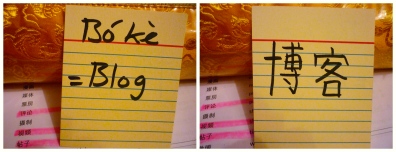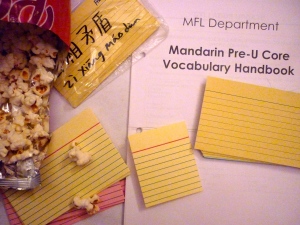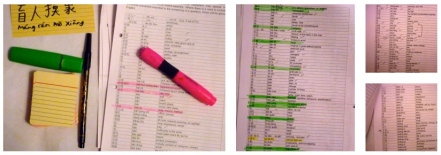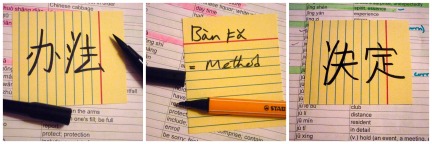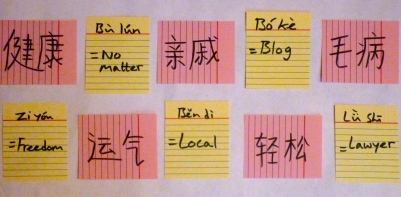It’s a strange coincidence that I was explaining how to pronounce my Chinese name to a friend of mine earlier today. I guess I have started this post in a somewhat reversed order. The coincidence that I am referring to is something that came up on my recent site statistics; 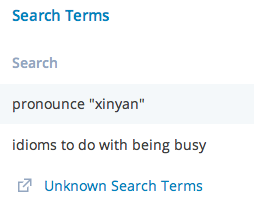 I’m not entirely sure if I have covered the title topic in an earlier post, but your response to actively search the pronunciation of my name is the most opportune moment for me to elaborate how to pronounce Chinese characters. To keep it simple we shall focus mainly on Pinyin, which as you know is the transliteration of Chinese characters (characters are types of non-romanised words). Also, I am speaking of pronunciation in terms of how things sound and nothing else.
I’m not entirely sure if I have covered the title topic in an earlier post, but your response to actively search the pronunciation of my name is the most opportune moment for me to elaborate how to pronounce Chinese characters. To keep it simple we shall focus mainly on Pinyin, which as you know is the transliteration of Chinese characters (characters are types of non-romanised words). Also, I am speaking of pronunciation in terms of how things sound and nothing else.
To begin let me clarify that my Chinese name 欣妍 is spelt with the pinyin of Xinyan, and is more precisely pronounced as ‘Shin yen’. The noticeable confusion between the official pinyin and the revised transliteration that I have provided is that they are both written differently. The problem that arises from this is that whilst a student of Chinese may be able to read characters, their pronunciation may be slightly lacking because the way that the pinyin is written is not necessarily how the character is to be read. At times acknowledging this as a problem is good and ensures that we can improve (加油).
I think the most useful way for me to show you how characters are pronounced is through the format in my post on numbers. Here are some of the most common consonants that are found in pinyin, when reading characters:
- The letter ‘x’ is used a lot (also in my name) and is read with the ‘sh’ sound. E.g. 学习 ‘xue xi’ (‘to study’) is read as ‘shu-eh shee’.
- Generally when the letter ‘c’ is used in pinyin the sound is actually ‘ts’. E.g. 参加 ‘can jia’ (‘to participate’) is ‘tsan jia’.
- ‘Zhu’ e.g. 祝(‘to wish’) sounds like ‘joo’
- 饿 (‘hungry’) An ‘e’ on its own usually makes a sort of ‘uh’ sound.
- 吃 ‘chi’ (‘to eat’) is ‘chuh’ (it’s less difficult than it looks, simply takes recognizing).
- If you combine the last three points you will arrive at ‘zhe’ e.g. 这 (‘this’). This is pronounced as ‘juh’.
- Sometimes you may see pinyin that includes the letter ‘u’ with two dots above the letter. To pronounce this properly you need to sort of round your mouth. For example 绿 ‘lǜ’ (green) sounds like ‘lyew’, but it’s quite subtle.
- 奥 ‘Ao’ e.g. from奥运会 (the Olympics) is pronounced with an ‘au’ sound.
For some of the examples like those in number 5 and 6 it is quite difficult to accurately relay the pronunciation without auditory supplements, so I have simply provided you with the foundations in pronunciation. For number 7, Luhan formerly of Exo has a tendency to speak as if most of his words have the two dots above the letters, so you can bear that in mind if you are having trouble with the letter (if you are familiar with his speaking then let me know if you agree). As you may have already noticed, with certain consonants that I have not introduced you may have to combine some of the principles that I have already shown, but generally it is not difficult to come to grips with. I also just noticed that the way your tongue moves behind your teeth for letters like ‘ts’ is similar to how you read some of the Arabic letters!
I wanted to provide you with an audio clip so that you can hear the pronunciations when being used. This video sounds cute at the start but the monotone may bother you after a minute or two. Still, it’s good because it covers the pronunciation of the entire alphabet https://www.youtube.com/watch?v=b9Ayvjy-Dgs If you can watch this video without laughing or a small grin then 祝贺你. Another video is something my teacher showed us during lesson that we couldn’t finish in class due to the length, but the presenter does effectively explain how to pronounce the tones https://www.youtube.com/watch?v=3wV8B4bx1lM . Lastly the final video link is something that I only just came across https://www.youtube.com/watch?v=NMUoZjVweVY . The video length is fairly short, and the presenter expands on explaining the pronunciation of some of the difficult consonants in Chinese.
If you look at the screen capture picture I started the post with, another topic that you have been searching for are idioms to help you when you are busy. I may have mentioned this in the past, but I try to prioritise educational commitments over secondary activities such as my blog for quite obvious reasons. As when I had started this blog last year, I still have a list of posts I plan to write about which tend to be side swept because I tend to go with things that are spontaneously relevant (…if that makes sense). I wanted to highlight that I have noticed the interest in my posts related to being busy and therefore I will try to write something that may help you alleviate your stress, or deal with being busy in the near future. As requested by one of my previous Chinese teachers, I also want to write about some effective ways to revise for Mandarin to expand on my previous post, which I think would be beneficial, and indirectly help with the problem of being busy. 将来我会帮助你应付你的忙,压力和问题等。I do still welcome requests or suggestions 🙂
If you stayed till the end, thank you for reading the update.
If you try to pronounce Chinese characters, goodluck 世界。
从欣妍 – From Xinyan.

